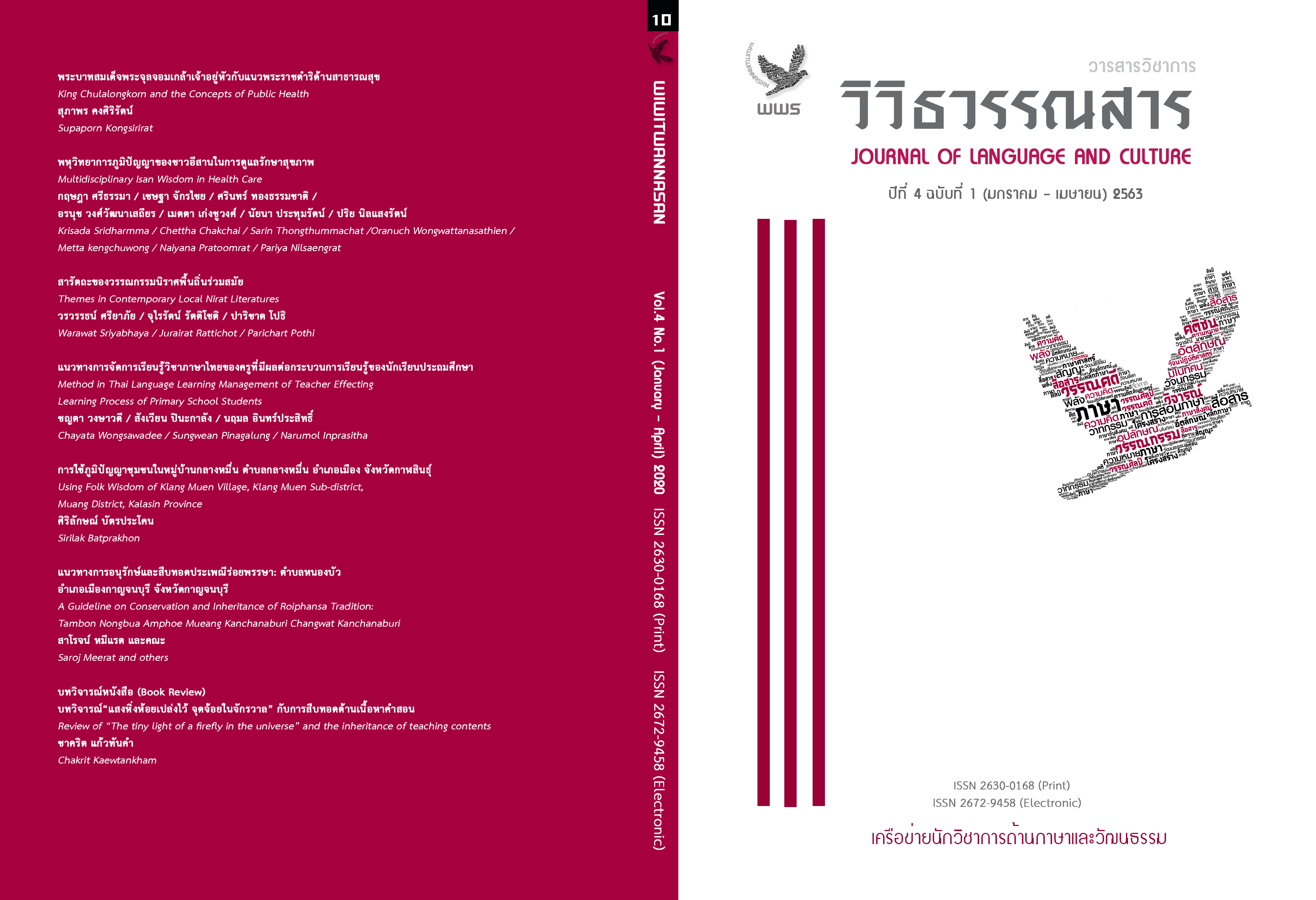แนวทางการอนุรักษ์และสืบทอดประเพณีร่อยพรรษา : ตำบลหนองบัว อำเภอเมือง จังหวัดกาญจนบุรี
Main Article Content
บทคัดย่อ
งานวิจัยครั้งนี้มีวัตถุประสงค์เพื่อศึกษาประวัติความเป็นมาของประเพณีเพลงร่อยพรรษา และหาแนวทางการอนุรักษ์และสืบทอดประเพณีการร่อยพรรษาของชุมชนบ้านหนองบัว ตำบลหนองบัว จังหวัดกาญจนบุรีวัตถุประสงค์ของการร่อยพรรษา โอกาสที่เล่น การแต่งกาย อุปกรณ์ที่ใช้ ขั้นตอนและวิธีการในการเล่น เนื้อร้องและทำนองเพลง รวมถึงแนวทางในการอนุรักษ์และสืบทอดเพลงร่อยพรรษาอย่างเป็นระบบ เพื่อให้ประเพณีนี้คงอยู่กับชาวหนองบัวสืบไป กลุ่มประชากรที่ใช้ในการวิจัยแบ่งออกเป็น 2 กลุ่ม ได้แก่ กลุ่มพ่อเพลงแม่เพลงกลุ่มหนึ่ง และกลุ่มผู้นำชุมชนกับชาวบ้านหนองบัวอีกกลุ่มหนึ่ง
ผลการวิจัยสรุปได้ดังนี้ ประเพณีร้องเพลงร่อยพรรษาของชาวบ้านหนองบัวมีมาแล้วไม่น้อยกว่า 150-200 ปี เป็นการเรียนการร้องเพลงแบบมุขปาฐะ (Oral Tradition) มีวัตถุประสงค์เพื่อขอบริจาคเงินจากชาวบ้านไปทอดกฐินให้กับวัดศรีอุปลาราม เพื่อทางวัดจะได้นำเงินไปใช้ในการบำรุงพระพุทธศาสนา และซื้อสิ่งของที่มีความจำเป็นถวายวัด โอกาสที่เล่นประเพณีร่อยพรรษาคือช่วงออกพรรษาแล้วเป็นเวลาประมาณ 10 วัน โดยพ่อเพลงแม่เพลงที่จะออกร้องเพลงร่อยพรรษาจะรวมกันเป็นกลุ่มประมาณ 6-10 คนจะแต่งกายเหมือนชาวบ้านทั่วๆ ไป พร้อมอุปกรณ์ในการออกร่อยพรรษา ได้แก่หมวก ไม้เท้า ย่าม และพาน ก่อนออกร่อยพรรษาจะประชุมกำหนดพื้นที่ กำหนดตัวผู้ที่จะจดบันทึกจำนวนเงิน และเก็บรวบรวมเงินในแต่ละวัน เมื่อครบ 10 วันจะนำเงินที่ได้รับบริจาคมานับต่อหน้าสาธารณชนเพื่อความโปร่งใส และนำเงินส่วนหนึ่งทอดกฐินถวายวัดอีกส่วนหนึ่งนามาซื้อสิ่งของที่จำเป็นถวายพระภิกษุสงฆ์
เนื้อเพลงร่อยพรรษาสำนวนของชาวหนองบัวเป็นกลอนที่มีจำนวนตั้งแต่ 5-10 คำกลอนประกอบด้วยเพลงเดิน เพลงชมบ้าน เพลงขอ เพลงให้พร และเพลงลา ทำนองของเพลงไม่มีจังหวะที่แน่นอน ใช้ระดับเสียงเพียง 4 เสียงได้แก่ ลา โด เร และฟา ขึ้นต้นเพลงด้วยเสียง ลา และลงท้ายด้วยเสียงโด ทุกเพลง ทำนองของเพลงมีการร้องแบบที่มีลูกคู่รับหรือที่เรียกว่า Refrain
ประเพณีร่อยพรรษาของชาวหนองบัวกำลังจะสูญหายไปเนื่องจากขาดผู้สืบทอดที่สามารถร้องเพลงนี้ได้ ขาดงบประมาณ เยาวชนไม่สนใจ และขาดการจัดการในการอนุรักษ์และสืบทอดประเพณีนี้อย่างเป็นระบบ ดังนั้นชาวบ้าน ผู้นำชุมชน และหน่วยงานราชการในชุมชนควรร่วมกันหาแนวทางในการอนุรักษ์และสืบทอดประเพณีนี้อย่างมีระบบ เทศบาลตำบลหนองบัวควรกำหนดเป็นแผนของหน่วยงาน ในการจัดสรรงบประมาณเพื่ออนุรักษ์และสืบทอดประเพณีร่อยพรรษาอย่างต่อเนื่อง โดยขอความร่วมมือให้หน่วยงานต่างๆ เข้ามาร่วมกิจกรรม นอกจากนี้มหาวิทยาลัยราชภัฏกาญจนบุรีควรจะมอบหมายสำนักศิลปะและวัฒนธรรมให้ร่วมมือกับท้องถิ่นอีกทางหนึ่งในการอนุรักษ์และสืบทอดประเพณีนี้
Article Details
ลิขสิทธิ์ของบทความเป็นของวารสาร การพิมพ์ซ้ำจะต้องได้ร้บการอนุญาตจากบรรณาธิการวารสาร
เอกสารอ้างอิง
ศูนย์วัฒนธรรมจังหวัด. (2527). สรุปย่อไทยคดีพื้นบ้านจังหวัดกาญจนบุรี. กาญจนบุรี: วิทยาลัยครูกาญจนบุรี.
ศูนย์ศิลปวัฒนธรรม วิทยาลัยครูกาญจนบุรี. (2530). เพลงพื้นบ้านพนมทวน. กาญจนบุรี: .ม.ป.พ.
สำนักงานวัฒนธรรมจังหวัดกาญจนบุรี. (2548). สารัตถะและบริบทด้านศิลปะการแสดง: เพลงร่อยพรรษาของจังหวัดกาญจนบุรี. กาญจนบุรี: ผู้แต่ง.


